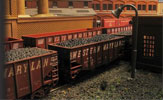
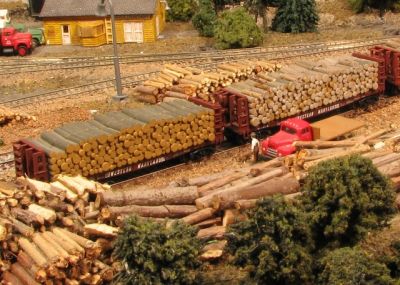
The car on the left has the original stock load, the car on the right has been improved upon.
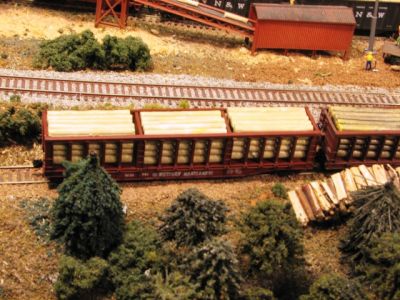
This is the old pulp rack by Atlas. The printing wasn't as crisp, and the car isn't an accurate model for the WM, but I like the looks of them, and enjoy keeping these relics of the 60's rolling.
Improving the Pulpwood Loads
The New Car
The later runs of the Atlas Pulpwood Flat is a huge improvement over the 1960's version that was produced overseas. However, the pulpwood load that's included with it has some particular flaws that prototype modelers have complained about.
First, both sides of the load are identical, creating a uniform profile across the top of the load. Given the random nature that pulpwood is cut, this is not a realistic look. Also, in my opinion, the colors on the load are too flat, and a little cartoony. The majority of the car's weight is located inside the load, which we cover in the right hand column.
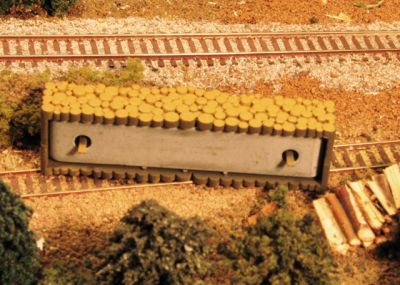
I set about to fix both of these problems with the goal of making the load appear more random, and use paint and weathering techniques to give it a more realistic appearance.
Fig. 1 diagrams 2 stock loads Note that the logs are aligned on both sides.
Fig. 2 diagrams the loads after I cut and rotated both loads, swapped sides and reassembled. Much more random.
The key to success, though, is to make sure the two mounting tabs the are present inside the load, stay on one side when you cut the shell in half down the center line. Try not to cut too close to them, either as they need to be stable enough to lock the load to the car deck.
Next, I added some natural twigs trimmed from various shrubs in my yard, and cut to a length close to the size of model logs, and a little longer. Then, using CA adhesive, I glued several onto the tops of each row, to help camouflage the gap where the saw cut is, and to add a little more randomness and texture to the load., then using colors that closely matched the natural twigs I had used to build up my pulpwood stacks in the paper mill yard, I added some more color and texture to the load to really make it pop.
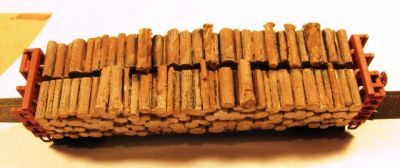
The load is just as easy to remove to run empties as the original, but it looks a whole lot better.
Improving Atlas Pulpwood Flats
Having a paper mill operation on the layout generates a lot of traffic for my model railroad to handle, inbound wood chips, chemicals, packaged kaolin and pulpwood, and outbound finished goods, waste chemicals and by-products is enough to keep a switcher busy 24-7.
The pulpwood and wood chip traffic requires some specialized equipment, and I'll be showcasing some of it on this page.
The photo at left shows a more or less stock Atlas 55 ton fishbelly hopper with a an extension above the top sill cut from another Atlas car. I also scratch built a few. The height of the extension should be 3'6". During the 1960's, the WM converted much of its fleet of 55 ton hoppers into 66 tonners, but 20 of them survived as wood chip cars like this one. I'll be putting together a photo essay showing the basics. Stay tuned.
First, here's a look at making some minor modifications to the old and new Atlas Pulpwood Cars look and run a little better.
Improving The Cars
The N scale Atlas Pulpwood Car is a decent model that is fairly representative of the WM's fleet of class F-19 bulkhead flatcars, which were built in June and July of 1962 in the WM car shops, according to the WM Color Guide to Freight and Passenger Equipment (Jack Brown, 1995 Morning Sun Books). The cars could load up to 21 cords of wood. They were used to collect pulpwood from the branches surrounding Elkins on the Thomas Sub, and deliver it to the paper mills at Luke, Maryland and Glatfelters, Pennsylvania. Roster numbers for the class were 401-410. Atlas has offered numbers 403, 405 and 407 so far, and as of this writing, Nos. 406 and 410 are being offered.
Long ago in a galaxy far, far away, Atlas offered another pulpwood car, a 3-bay 55' car with racks with top rails as well as end bulkheads. The only number offered back then was 756, which according the Brown book, never existed. I have four of these rostered, which I renumbered in the fictitious series of the original. I like them more for being nostalgic N scale models than accurate WM cars.
We'll look at both of these cars and make some modifications and improvements to their appearance, as well as their operating characteristics.
The New Car
Since I run car card and waybill operations, I will remove the loads to run empties back to the source of the timber. I quickly discovered that the new Atlas car is very light weight. This is due primarily to the car weight being a part of the load assembly, and not the car itself. The car's frame is die-cast metal, which helps, but it is still deficient. When using a magnetic uncoupling ramp, the action on the trip pin was enough to actually de-rail the car.
 I solved this problem by cutting some sheet lead and forming "ingots" that fit between the ribs of the underframe. Once these were installed, the tracking improved considerably.
I solved this problem by cutting some sheet lead and forming "ingots" that fit between the ribs of the underframe. Once these were installed, the tracking improved considerably.
While I was down there tinkering, I also changed the coupler boxes from being truck mounted to body mount. I used the same procedure I used on my 55 Ton Fish Bellies (also by Atlas) wherein I nipped the coupler box from the truck, then attached it to the frame with a dab of CA adhesive  (Crazy Glue and that ilk) This further improved the coupler action, since the truck was no longer affected by the movement of the trip pin. Due to the design of these cars, you can't swap the trucks for Micro Trains truck/coupler combos. I've found that body mounting Accumates also tends to dramatically improve their reliability, reducing uncouplings at the least opportune moments. An added benefit is you can also reduce the coupling distance between cars by mounting the draft gear back slightly from the end sill.
(Crazy Glue and that ilk) This further improved the coupler action, since the truck was no longer affected by the movement of the trip pin. Due to the design of these cars, you can't swap the trucks for Micro Trains truck/coupler combos. I've found that body mounting Accumates also tends to dramatically improve their reliability, reducing uncouplings at the least opportune moments. An added benefit is you can also reduce the coupling distance between cars by mounting the draft gear back slightly from the end sill.
The Old Car
This car is also fairly light when unloaded, and can track poorly when loaded as well. The first thing I did here was swap the trucks and couplers for MT roller bearing trucks with short extension couplers. I also replaced the wheelsets with Low Profile wheels from Atlas to work with their code 55 track.
I then set about to renumber three of the cars, which I did with Micro Scale decals.
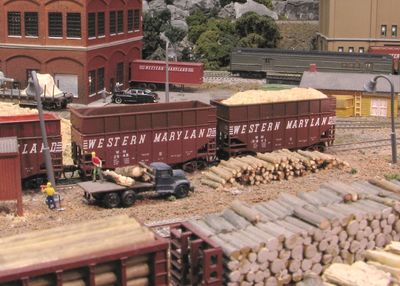 Wood Chip Hoppers
Wood Chip Hoppers